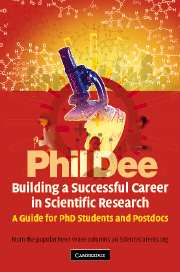Book contents
- Frontmatter
- Contents
- Foreword
- Preface
- PART I The first couple of years
- PART II The end of the beginning
- 6 Writing papers and abstracts
- 7 Conferences and poster presentations
- 8 Writing and defending your thesis
- 9 Coping with pressure and stress
- PART III The transition to post-doctoral research
- PART IV Making it in science
- Epilogue
- Web-links
- Index
8 - Writing and defending your thesis
Published online by Cambridge University Press: 05 June 2012
- Frontmatter
- Contents
- Foreword
- Preface
- PART I The first couple of years
- PART II The end of the beginning
- 6 Writing papers and abstracts
- 7 Conferences and poster presentations
- 8 Writing and defending your thesis
- 9 Coping with pressure and stress
- PART III The transition to post-doctoral research
- PART IV Making it in science
- Epilogue
- Web-links
- Index
Summary
Writing your thesis
I defy anyone to argue that there's an easy way to write a Ph.D. thesis. OK, so you can be organised and efficient about it, but, as far as I'm concerned, a Ph.D. isn't the top qualification without good reason. For me, the ‘good reason’ is the very process of constructing the thesis. Unless you are a natural born writer, it can be a bit of a slog.
After three years of hard work, and with the prospect of a salary only a couple of months away, I remember feeling a little radical towards my own thesis. So, I decided to break all the rules. I tackled the whole thing in one go, a sort of shotgun approach to thesis writing. Whilst perhaps unorthodox, I found this method extremely satisfying and very effective. The basic idea is to touch everything – every result, every paper – once and only once. You pick it up, look at it, make a decision and slot it right in where it needs to go. The object is to clear those piles of paper relatively quickly and get everything in electronic format as fast as possible. Once everything, and I mean everything, is on disk the battle is half won.
First, crack on with your figures and tables. Taking them each in turn, describe exactly what results you've got. You can use these descriptions as your figure and table legends, and a bit later on as the basis for your results sections.
- Type
- Chapter
- Information
- Building a Successful Career in Scientific ResearchA Guide for PhD Students and Postdocs, pp. 52 - 58Publisher: Cambridge University PressPrint publication year: 2006



